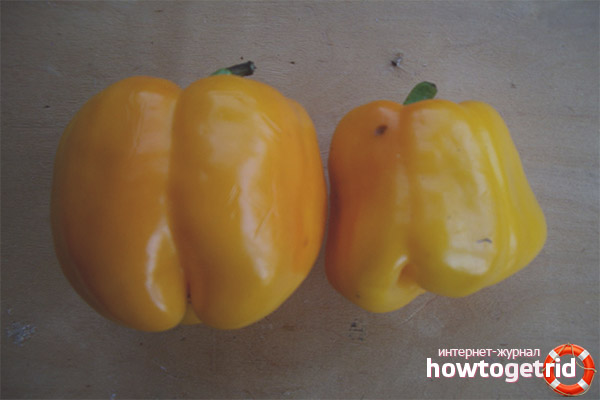The content of the article
This pepper variety is a mid-season species bred by Siberian breeders. Suitable for cultivation in open soil, as well as under film shelters. The ripening begins on the 110–115th day after seed emergence.
A semi-spreading bush that reaches 70 cm in height. In this case, the garter to the support and the formation is not required. It has large wrinkled leaves of a dark green color.
Since 2006, it has been included in the State Register of the West Siberian Region for planting in open soil or film shelters for use in personal subsidiary plots.
Fruit characterization
The fruits are drooping, have a cylindrical shape with a wall thickness of up to 8–9 mm. They are distinguished by large size and weight of about 150-200 grams, as well as juiciness and excellent, without bitterness, taste. Coloring depends on the stage of maturation and varies from dark green to dark yellow. Crop is approximately 178–297 tons per 1 ha.
Ideal for cooking fresh salads, as well as any method of heat treatment.
Cultivation agricultural
For germination, seeds are planted about 60-70 days before transplanting into open ground. The most suitable temperature regime for proper development and growth is approximately 26–28 ° C.
The first sprouts appear on the 12-15th day. As soon as the pepper has two real leaves, it must be dived. For this, separate cups of 0.3-0.5 liters are used for each plant.
This variety is unstable to soil changes, so a temporary halt in growth after a dive is quite likely. After transplanting, pepper must be treated with special preparations from parasites. In case of contact with the plant, the foliage is thoroughly washed.
Soil must be loosened and fertilized with organic substances in advance. Do not forget about weeds - they should not be on the bed.
The plant is extremely positive about watering and top dressing, but this should not be abused so as not to flood or burn the roots of the seedlings. The best option is watering in the morning and evening, and top dressing in an amount of two to three times during the summer. The fertilizer solution should be light, not concentrated.
Outdoor planting
Transplanting seedlings into the open soil is possible only with full confidence that frosts will not repeat again. Depending on the climate of the region, it can be placed directly in the ground or use covering material, a film. The row spacing on the bed should be at least 40 cm with a gap between bushes of 20–25 cm.
The calculation of the total number of plants needed to fill the beds is based on the number of 4 pcs. per 1 square. meter of land. No need to make deep holes. It is best to plant pepper in the same way that it grew in glasses. In order for the pepper to adapt faster, you can dive it together with the ground from the container. And also it is worth considering that it does not give lateral roots, and therefore does not need a deep hole.
Do not allow the soil to fall asleep on the leaves of the plant. It is preferable to dive in the evening, in the absence of direct sunlight. This will prevent the risk of burn seedlings. Do not forget about watering and mulching.
The fruits ripen near the end of the fourth month of growth, subject to the rules of care and feeding.
Video: growing pepper from A to Z










Submit